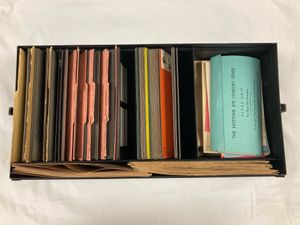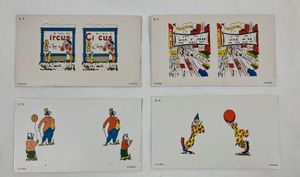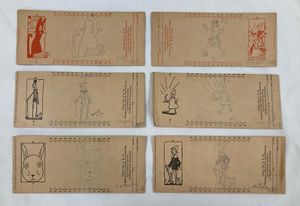Author: Sylvia Benjamin, Intern, Truhlsen-Marmor Museum of the Eye®
While interning at the Museum of the Eye, I had the opportunity to become more familiar with the collection. The other day, I was helping catalogue objects and came across several rather unassuming boxes labeled “Home Training Kits.” They were manufactured by Keystone View Company, circa 1940. Inside the boxes were a series of papers and pictures that, to the untrained eye, looked to be almost unrelated to each other. They were colorful, containing drawings and photos reminiscent of a child’s toy. Although these may have been used by children, it turned out they were not toys. The kits were prescribed to patients to help improve their binocular vision and train their eyes to work together. As an undergrad at Temple University, I’m interested in careers in physical therapy and other health professions that help patients build their abilities in the long term. This idea of “training the eyes” was particularly interesting to me so I had to know what these objects were.

A box of colorful home tests in collections storage
The first step I took to understanding the kits was to ask, “who helps solve movement and focus issues in the eyes, and how?” Talking to the Museum Director, Jenny Benjamin, she suggested I look into the profession of orthoptics. Orthoptics is a health profession allied with ophthalmology. Orthoptists manage eye movement disorders non-surgically, treat fusion and accommodation problems, as well as help to improve binocular vision. Orthoptists use eye patches, prisms, and lenses among other techniques to help adults and children.
I learned that people have been interested in the movements and muscles of the eyes for thousands of years, but orthoptics as a profession was not introduced until much later. In the 1860s, the ophthalmologist Louis Émile Javal (1839-1907) became interested in “physiological optics,” or how light entering the eye is translated to the brain. This led him to study strabismus, and he introduced the use of exercises, surgery, and the stereoscope to treat it. Today, Javal is recognized as the Father of Orthoptics and a pioneer of orthoptic treatment of strabismus.


Examples of training cards designed for children
The kits in the museum’s collection contain stereoscopes and training cards. They were made over 70 years after Javal’s studies, around the time orthoptic societies were founded around the world to establish standards for the profession. They were manufactured by Keystone View Company which sold stereoscopes and slides to schools for educational purposes and to individuals for home entertainment. In 1932, the company formed a Stereoscophthalmic Department specifically to supply therapeutic kits to health professionals, including orthoptists. Some kits were meant for use in an office to both diagnose and treat individuals with binocular vision problems. Other kits were made for a patient to take home. These were prescribed for specific types of therapy, based on what needed correcting. All the kits were supposed to “exercise the eyes” and to help the eyes work together in harmony.
Tracing exercise cards
The eye training kits in the museum’s collection each contain a stereoscope, cards with various exercises, and progress logs. In one, the patient was asked to look at images through a scope and pay attention to the different objects or words pictured. In another, patients were asked to perform tracing exercises which were said to strengthen the connections between the mind, hands, and eyes. For the tracing exercise, the patient was given an instrument with a division down the middle, so each eye had a separate field of vision. The patient’s stronger eye could only see a reference image, while the weaker eye could only see a blank area on the card. During the exercise, the patient was expected to draw the image inside the blank area, preferably using the hand on the same side.
The museum’s training kits were a surprising find in the collection, and I was glad to have the opportunity to learn about the foundation of orthoptics and Dr. Javal’s work.